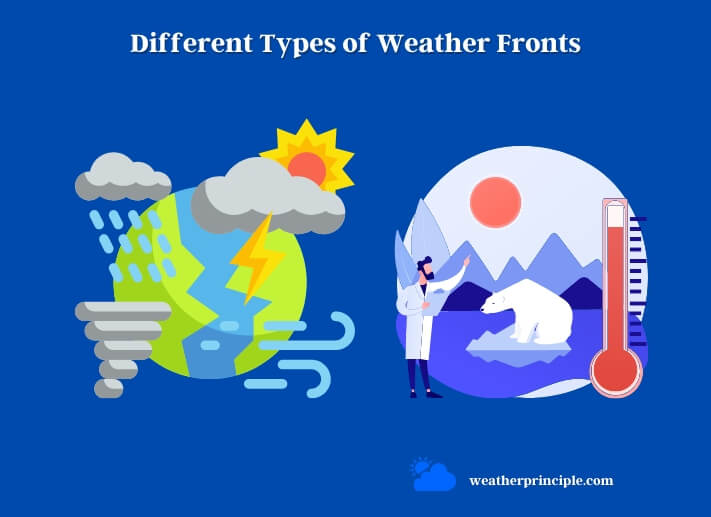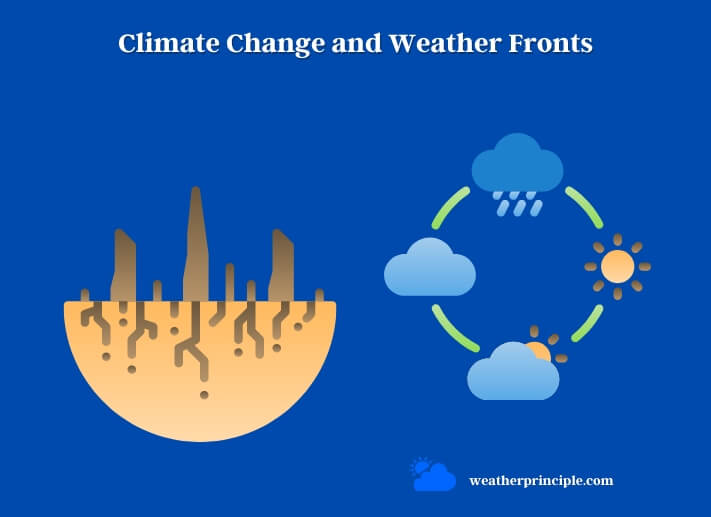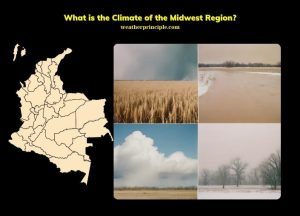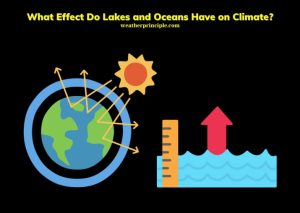Published on: May 13, 2023
Written by Taha Nur / Fact-checked by Kader Khan
Weather is an ever-changing phenomenon, making it both fascinating and challenging to predict. One of the key players in shaping our weather is the presence of weather fronts. These invisible boundaries separate air masses of different temperatures and humidity levels, leading to the formation of various weather events. In this comprehensive guide, we’ll delve into the world of weather fronts, explore their types, how they form, and their effects on our day-to-day lives.
Weather fronts play a vital role in shaping our day-to-day weather conditions, often serving as harbingers of significant changes in weather patterns. From sudden temperature shifts to severe storms, understanding weather fronts can help us better prepare for various meteorological phenomena.
A weather front is a boundary separating two distinct air masses with different temperature, humidity, and pressure characteristics. As these air masses collide and interact, various weather conditions can arise, ranging from gentle rain to thunderstorms and even tornadoes.
Different Types of Weather Fronts
Cold Fronts
Formation of Cold Fronts
A cold front occurs when a cold air mass advances and replaces a warmer air mass. The denser cold air forces the warm air to rise, often resulting in the formation of clouds and precipitation.
Associated Weather Patterns
Cold fronts are typically associated with rapidly falling temperatures, gusty winds, and heavy precipitation, often followed by clearing skies and cooler weather.

Warm Fronts
Formation of Warm Fronts
Warm fronts develop when a warm air mass moves into an area occupied by a colder air mass. As the warm air rises above the cold air, it cools and condenses, forming clouds and precipitation.
Associated Weather Patterns
Warm fronts often bring gradual temperature increases, light to moderate precipitation, and an increase in humidity, followed by warmer and more humid conditions.
Stationary Fronts
Formation of Stationary Fronts
A stationary front forms when two air masses meet but neither has the strength to displace the other. These fronts remain relatively stationary, with winds blowing parallel to the boundary.
Associated Weather Patterns
Stationary fronts can produce extended periods of cloudy and wet weather, as well as localized flooding due to persistent rainfall.
Occluded Fronts
Formation of Occluded Fronts
An occluded front develops when a cold front catches up to a warm front, forcing the warm air upward and creating a complex interaction between the air masses.
Associated Weather Patterns
Occluded fronts can bring a mix of weather conditions, including rain, snow, and even thunderstorms, followed by clearing and cooling.
Detecting and Tracking Weather Fronts
Meteorological Tools and Techniques
Weather Maps
Weather maps are essential tools for tracking fronts and understanding their potential impacts. Symbols and lines on these maps indicate the type and location of various fronts, allowing meteorologists to forecast weather changes.

Satellite and Radar Imagery
Satellite and radar imagery provide valuable real-time data on cloud cover, precipitation, and storm development, enabling meteorologists to monitor the movement and evolution of weather fronts.
Weather Front Symbols and Terminology
Standard symbols and terminology are used to represent different types of weather fronts on maps and charts. For example, a blue line with triangles represents a cold front, while a red line with semicircles indicates a warm front.
The Role of Weather Fronts in Forecasting
Weather Patterns
By studying weather fronts, meteorologists can gain insights into the patterns and processes driving our weather. This knowledge allows them to predict temperature fluctuations, precipitation events, and other meteorological phenomena with greater accuracy.
Predicting Severe Weather
Thunderstorms
Weather fronts can contribute to the development of thunderstorms, particularly when warm, moist air is forced to rise rapidly along a cold front. Meteorologists closely monitor these frontal boundaries to anticipate and issue warnings for potential severe weather.

Tornadoes
Tornadoes often form in association with powerful thunderstorms along cold fronts. By tracking the movement and strength of these fronts, meteorologists can provide advance notice of potential tornado outbreaks, helping communities prepare for these dangerous events.
Winter Storms
Winter storms can be fueled by the interaction of cold and warm air masses along weather fronts. Accurate tracking and analysis of these fronts enable meteorologists to forecast the timing, intensity, and impacts of snow, sleet, and freezing rain events.
Climate Change and Weather Fronts
The Impact of Climate Change on Frontal Systems
Climate change is altering the behavior of weather fronts, with potential consequences for weather patterns and extreme events. For example, some research suggests that warming temperatures could cause fronts to stall more frequently, leading to prolonged periods of heavy rainfall and an increased risk of flooding.
Future Implications for Weather and Climate
As the Earth’s climate continues to change, understanding the evolving dynamics of weather fronts will become increasingly important for accurate weather forecasting and climate modeling. Ongoing research into these processes is critical for informing adaptive strategies and mitigating the impacts of extreme weather events.

Real-life Examples and Case Studies
Historical Weather Front Events
Throughout history, weather fronts have played a role in shaping significant weather events. Examples include the Great Flood of 1993, the record-breaking cold wave of 1985, and the deadly tornado outbreak of 2011.
Notable Severe Weather Outbreaks
By examining past severe weather outbreaks in relation to weather fronts, meteorologists can better understand the conditions that contribute to these events and work to improve forecasting techniques.
Summary
Weather fronts are a critical component of our global weather system, driving changes in temperature, precipitation, and other meteorological phenomena. Understanding the different types of fronts and their associated weather patterns is essential for accurate weather forecasting and preparedness. As climate change continues to alter the behavior of weather fronts, ongoing research and monitoring will be crucial for mitigating the impacts of extreme weather events.
Frequently Asked Questions (FAQs)
What causes a weather front to form?
Weather fronts form when two air masses with different temperature, humidity, and pressure characteristics collide and interact.
Why do weather fronts sometimes cause severe weather?
Severe weather can result from the interaction of air masses along weather fronts, particularly when warm, moist air is forced to rise rapidly, leading to the development of thunderstorms and potentially tornadoes.
How are weather fronts related to air masses?
Weather fronts serve as the boundary between two distinct air masses, with different temperature, humidity, and pressure characteristics.
Can climate change affect the behavior of weather fronts?
Yes, climate change can alter the behavior of weather fronts, with potential consequences for weather patterns and extreme events. For example, warming temperatures may cause fronts to stall more frequently, resulting in prolonged periods of heavy rainfall and an increased risk of flooding. As the Earth’s climate continues to change, understanding the evolving dynamics of weather fronts will become increasingly important for accurate weather forecasting and climate modeling.
Can weather fronts be seen with the naked eye?
No, weather fronts are not visible to the naked eye. However, the clouds and precipitation associated with them can be observed, which can give us clues about the presence of a front.
Are weather fronts responsible for all types of precipitation?
While weather fronts are a primary cause of precipitation, there are other factors that can lead to rain, snow, or other forms of precipitation. These include orographic lift, convection, and other meteorological processes.
Can weather fronts cause extreme weather events?
Yes, weather fronts can contribute to the development of severe weather events like thunderstorms, heavy rain, and blizzards. However, the severity of these events depends on various factors, including the intensity of the front, atmospheric conditions, and the presence of other meteorological phenomena.
How fast do weather fronts move?
The speed of weather fronts varies depending on the type of front and the prevailing atmospheric conditions. In general, cold fronts move faster than warm fronts, often traveling at speeds of 20 to 30 mph, whereas warm fronts tend to move at a slower pace, around 10 to 15 mph.
How do weather fronts affect local climates?
Weather fronts have a significant impact on local climates. As they move through an area, they can bring changes in temperature, humidity, and precipitation patterns. For example, a cold front may cause a sudden drop in temperature and increased precipitation, while a warm front may result in a gradual rise in temperature and higher humidity levels.
How can I identify an approaching weather front?
While you cannot see a weather front directly, you can observe its effects on the atmosphere. Signs of an approaching front may include:
- A sudden change in wind direction or speed
- An increase or decrease in temperature
- The formation of specific cloud types associated with the front (e.g., cumulus clouds for a cold front or stratus clouds for a warm front)
- A change in humidity levels
- The onset of precipitation
Relevant Resources:



